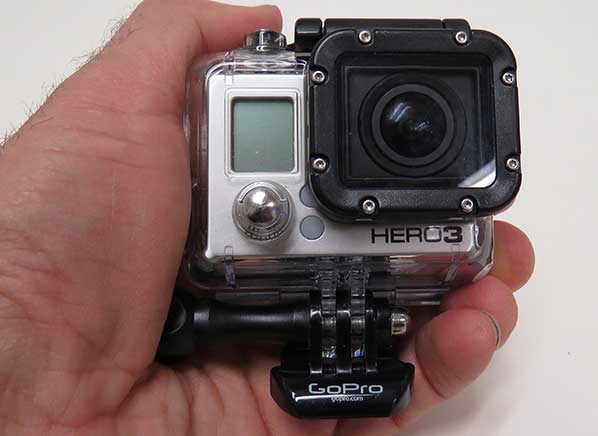A few years ago, GoPro reinvented the sports camcorder market with its line of small, compact models. Today, GoPro sports cams are now selling so well that 2012 market-share data placed GoPro as second only to Sony in terms of all total yearly camcorder sales. I recently spent some time with GoPro's latest model, the wireless Hero 3 Black Edition version ($400). Here's what I found:

Getting started. The first thing I did before using the GoPro model was to charge it via a USB cord. But right after I untethered the unit from my computer, it sometimes would freeze or lock up. When this happened, I had to reset the device.
GoPro suggests you update your new camcorder with the latest firmware (on-board software that runs device). This is a multistep process in which you connect your GoPro unit to the computer and allow the company's website to detect the model. It's not exceptionally complicated, but it does take some time, and there's a possibility the process might fail at any point. In comparison, the Sony Action Cam worked right after I charged it.
The GoPro Hero 3 has a claimed average battery life of between 1 and 1.5 hours. (Using Wi-Fi may drain the battery more quickly than happens with models that don't include wireless features.) The camcorder works with microSD memory cards for additional storage; the Action Cam can use either a microSD or a Sony Memory Stick Micro card.
Design. Like the Action Cam, the Hero 3 is designed for people who engage in outdoor sports and activities such as biking, surfing, and snowboarding. That's why both the Sony and GoPro camcorders are so small and lightweight, although the GoPro is just a touch smaller.
Find the right model for your needs and budget: Check out our camcorder buying guide and Ratings.
The GoPro is designed more like a point-and-shoot camera, with the lens and longer side at the front of the device. The Sony model has the lens built on the smaller end of the device. Like almost all sports cams, both lack a live-view LCD, which you'll find on full-size camcorders (although you can buy an LCD accessory for either model).
Each has a tiny black-and-white graphic display, which is where you set up the model. On the GoPro, you change and set the settings by clicking either the Mode button or the top Shutter button. (The Mode button makes a very loud beep, which you can tone down a little.) On the side of the GoPro, you'll also find the Wi-Fi button. All the controls worked well, as they did on the Sony camcorder.
The GoPro I shot with comes with some accessories, including a waterproof casing. I used it successfully in both the ocean and in a pool. And our testers found the GoPro survived our dunk test in 3 feet of water as well as our durability test in our Tumbling Barrel tester.
Wi-Fi and apps. This is the first GoPro to include built-in Wi-Fi, which lets you connect to a small, wireless remote control that can activate the camcorder's Record function. You can also use Wi-Fi to connect to a smart phone or tablet after you download the GoPro app to those devices. This lets you use your tablet or phone (either iOS or Android) to see what you're recording as well as to control other features.
The option to connect wirelessly to the app didn't appear in the setup menu until I downloaded the firmware update to the unit, though. Also, our testers found that there was a 3-second delay between the GoPro unit and what appears on the tablet or phone. If you're framing a shot, for example, this delay can be annoying.
Video quality and settings. The Sony Action Cam includes quite a number of settings, and the GoPro includes an even wider array, including a 4K setting. Although we didn't test it, the Hero 3 is among the first camcorders to include 4K settings for viewing on Ultra HD TVs. My guess is that few will use it, since few have such TVs and the frame rate is very low at just 12 frames per second, which means footage will be choppy, particularly action footage.
How do still cameras do with video? Find out in our buying guide and Ratings of digital cameras.
But our lab found the normal full-resolution HD setting, which captures 1080p at 60 frames per second, produced slightly better video quality than that of the Sony sports cam, with smoother horizontal motion. Still photos can be captured on the Hero 3, although it has very few settings. The GoPro produced middling footage in low-light settings for both video and still photos.
The Hero 3 also has additional settings to capture time-lapse photos, although it doesn't automatically stitch them into a video. You'll need to do this on a computer.
Bottom line. After a rocky start, I found the Hero 3 very easy to use. Underwater video looked especially good (see a sample below). The included remote control is also a nice extra. And like the Sony Action Cam, the Hero 3 functions well when synced with a smart phone or tablet. Both have wide-angle, non-zoom lenses, although the GoPro has a tad less fish-eye distortion than the Sony.
But the Black Edition of the GoPro Hero 3 is pricey at $400, which is more than $100 more than the Sony. (Also available are a White Edition, $300, and Silver Edition, $200, with fewer features). If you're hell-bent on capturing video of yourself catching a perfect wave when you're surfing or parachuting out of an airplane, though, the Hero 3 may be well worth the price.





